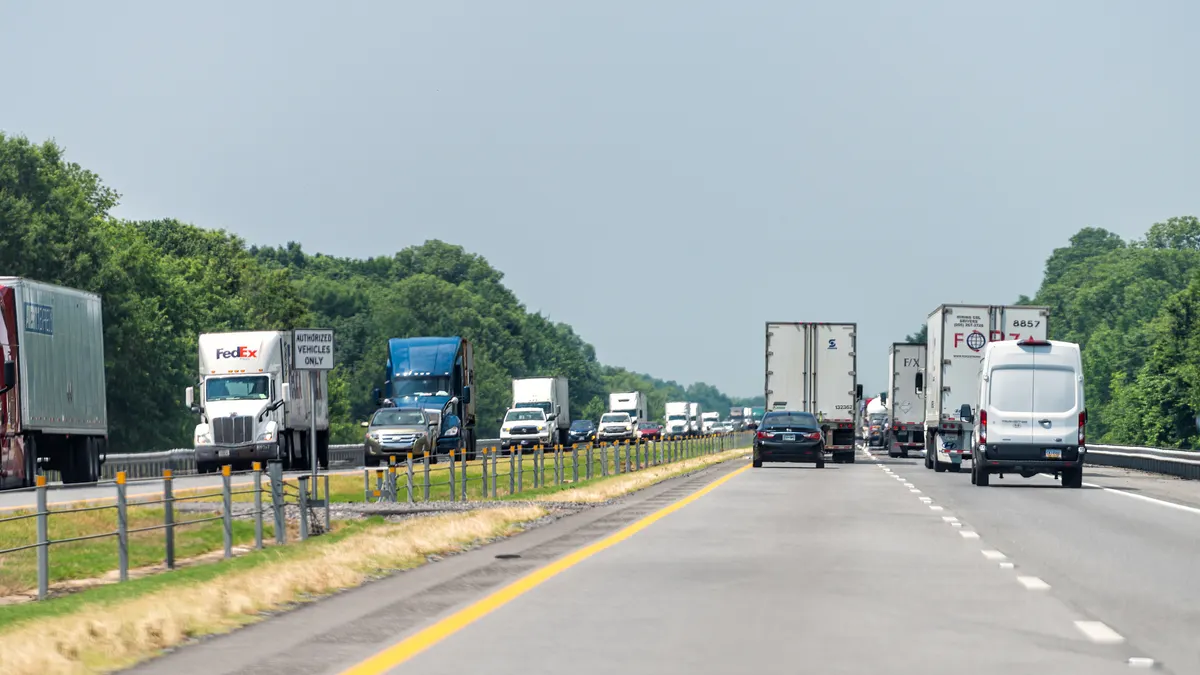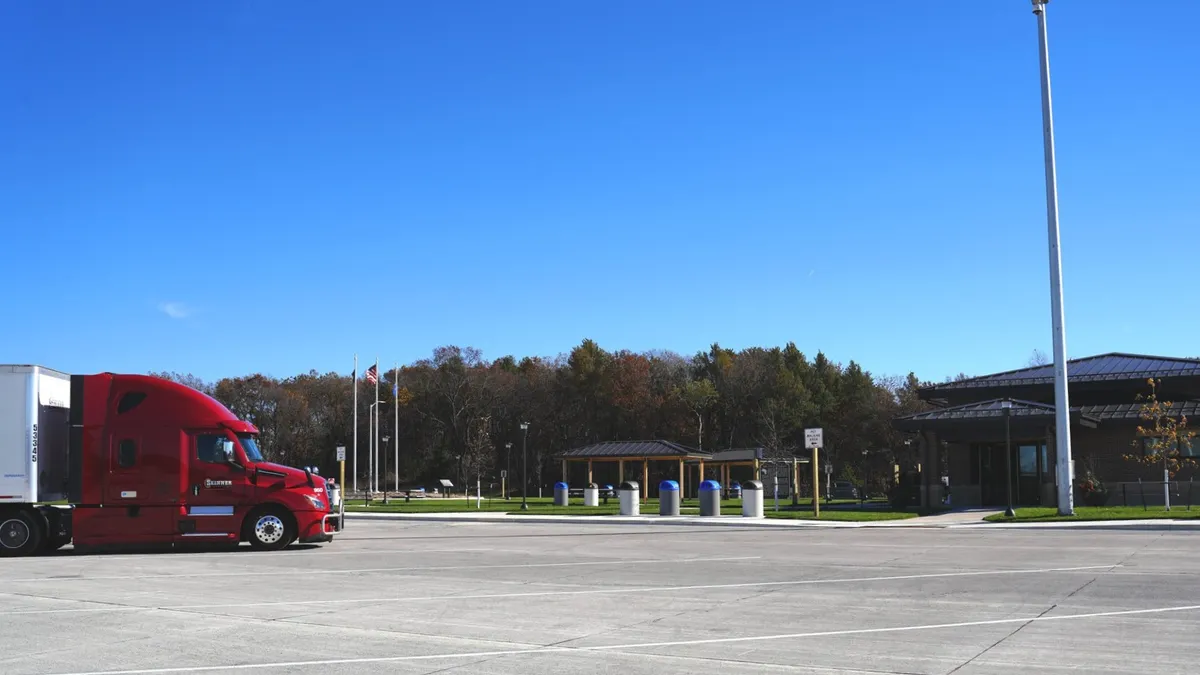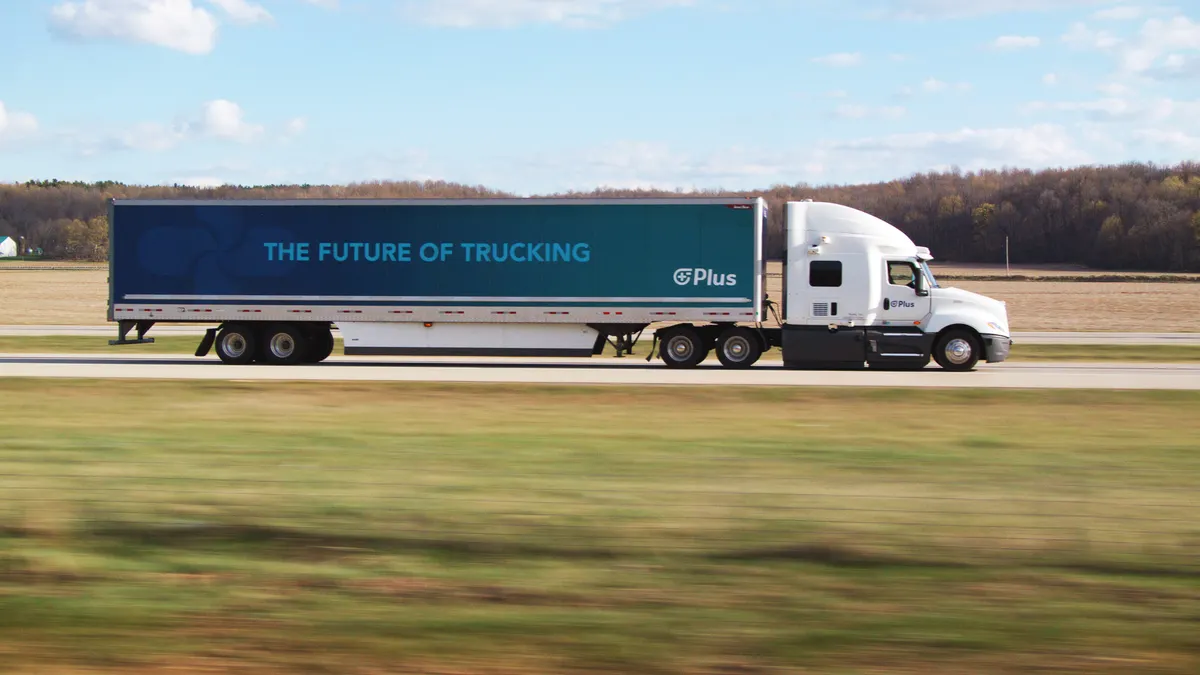A plunge in oil prices and, thus, diesel prices has given fleets some financial relief as COVID-19 puts a drag on freight demand and earnings.
Schneider National reported on April 30 that lower fuel costs helped offset some other problems in Q1. The company posted $42.9 million in net income, a 16% rise year over year.
Many trucking experts don't see diesel offsetting costs long term, because it's always a cycle. Trucking business officials told Transport Dive they wouldn't bet on cheap fuel. They have seen diesel prices usually creep back up to close to $4 per gallon.
"We've dropped to $2 diesel before," said Mike Roeth, executive director of the North American Council for Freight Efficiency. "It always comes back."
43.3 cents per mile
Fuel cost is usually one of the largest two fleet expenses. For 2018, the American Transportation Research Institute (ATRI) found driver compensation to be the top cost, at 59.6 cents per mile for wages and 18 cents per mile for benefits. Fuel cost 43.3 cents per mile. Driver compensation makes up about 43% of average marginal costs, according to ATRI's November 2019 update on operational costs. Fuel, about 24%.
To compound problems for fleets, there was no increase in heavy-duty trucks' fuel efficiency from 2017 to 2018. ATRI researchers Dan Murray and Seth Glidewell found miles per gallon remained at 6.4.

Fuel cost has since dropped dramatically, with West Texas Intermediate (WTI) oil for May delivery actually going negative in price for the first time in history. WTI oil stabilized on May 1 at about $20 per barrel, still a recent low.
The questions now are, will cheap oil last, and how will fleet behavior change?
"We've dropped to $2 diesel before. It always comes back."

Mike Roeth
Executive director, North American Council for Freight Efficiency
Roeth referenced 2011 to 2014, when diesel prices rose and then hovered between $3.75 and $4.15, per gallon. This was after the Great Recession dropped diesel to about $2 per gallon in March 2009. But after 2014, relief came. The United States had a boom in oil production, thanks to shale areas. Prices began to drop again, hitting $1.98 in February 2016, according to ATRI.
The U.S. freight boom, beginning in 2017, began to push diesel cost upward. Diesel averaged $2.399 for the week ending May 4, according to the Energy Information Administration. Diesel started the year at $3.079 per gallon.
Cost-cutting is nothing new
XPO told Transport Dive that its app allows company and affiliated drivers to find the cheapest possible fuel. Drew Wilkerson, the president of XPO's North American Transportation business, said in an email one driver recently scored the price of $1.08 per gallon outside of New Orleans.
Some companies prepared for volatility in diesel, so changes in diesel may not be noticed by shippers. UPS said it adjusts its fuel surcharge weekly, affecting the prices that its customers get. This makes changes in diesel a "non-event" for customers, UPS spokesman Glenn Zaccara said in an email to Transport Dive.

Indeed, much of the industry is prepared for upward pressure. Many fleets work to manage costs, buying newer fuel-efficient trucks and adding features that cut down on air resistance. Some fleets use skirts for trailers or attachments for the rear of the trailer. Others use wheel coverings.
One such feature is an aerodynamic tire covering that FlowBelow offers. The Texas company has factory offerings from the four major OEMs: Daimler Trucks North America, Volvo-Mack, Paccar and Navistar. It also produces tractor kits.
Yet it isn't $2 diesel that has FlowBelow President Josh Butler concerned. It is, rather, the poor state of the economy. The company's sales are tied to new truck sales, which ACT Research believes will drop 50% in 2020, to between 125,000 and 135,000 Class 8 units.
"Fortunately for us, [fleets] are not looking to cut aerodynamics."

Josh Butler
CEO, FlowBelow
Butler said the tractor kits can save fleets 2.23% on fuel, per truck. Those savings are still valuable, even with cheaper diesel, he said. It's a pitch he is making to customers, and one to which they are receptive.
"Fortunately for us, [fleets] are not looking to cut aerodynamics," said Butler.
And part of the reason, Butler told Transport Dive, is OEMs and fleets are savvy enough to know low diesel prices will not last.
On Wednesday, WTI oil was creeping back up, flirting with $25 per barrel. But it could take months for normalcy to return. Speaking to FreightWaves during its live web show on Wednesday, Werner Enterprises CEO Derek Leathers said diesel volumes are one of the most insightful statistics, and April's numbers were not good.
"Diesel does not lie. If diesel’s not flowing, if diesel's not being consumed, then you know that U.S. freight volumes are slowing," Leathers told FreightWaves.
Leathers said diesel usage indicates the U.S. freight economy is a few months away from a rebound.
Diesel runs into new concerns
Denton Cinquegrana, chief oil analyst for the Oil Price Information Service (OPIS), said diesel demand held up fairly well in the early stages of the COVID-19 crisis. It's perhaps why diesel demand didn't drop further, closer to $2 per gallon. Diesel price is down about 25% from where it was a year ago, he said.
But Cinquegrana said diesel prices could run into some new issues. Demand on the West Coast is slowing, Cinquegrana said, partially caused by import slowdowns at the ports. Asian imports into Los Angeles and Long Beach require a tremendous number of diesel-powered trucks and power units to move the containers from ships to trucks, he said.
"In the short term, diesel prices may stay down. There's some real concern about diesel over the next several weeks."

Denton Cinquegrana
Chief Oil Analyst, Oil Price Information Service
One of the reason for the downward pressure isn't just oil price. When refineries saw that demand for gasoline and jet fuel was likely to plummet, they minimized its production, while turning to diesel, Cinquegrana said. Now, trucks that met the panic-buying and restocking demand in March have less freight to move. Industrial production and factories have slowed, rates are declining and there isn't enough freight to keep the nation's trucks busy.
"In the short term, diesel prices may stay down," Cinquegrana told Transport Dive. "There's some real concern about diesel over the next several weeks."
But the fuel-price benefit to trucks may not have a stimulative effect on freight, because the Q2 economic performance will be bad, and evenly spread out over the economy. Cheaper shipping rates and fuel surcharges have to draw in customers, and that is a big unknown.
"Everyone is having a hard time right now," said Butler.
















